Engine's Cooling System Tips:
Radiator, Water Pump, Thermostat, Temperature Sensor, Coolant Recovery Bottle.
Click on the
 to
go to its Tip: to
go to its Tip: |
 |
Water Pump
|
 |
Temperature Switches Manifold (Upper engine coolant hose)
|
 |
Temp Sender/switch parts (Off Page link)
|
 |
Fan Temperature Sensor
|
 |
Fan Clutch Leak
|
 |
Fan Clutch
|
 |
Easy Fan Clutch Replacement
|
 |
Upgraded Radiator and Fans
|
 |
Auxiliary Transmission fluid and Engine oil Cooler
|
 |
Coolant Recovery Bottle
|
 |
Coolant Overflow Tube to the Recovery Bottle
|
 |
Smell of Antifreeze -- Coolant Bottle Overflow (off page link)
Head Gasket leak -- Compression in the Cooling System
|
 |
Coolant Thermostat
|
 |
Engine Cooling - Air flow to the Radiator (off page link)
|
 |
Ram-Air Cooling (off page link)
|
 |
Engine Overheating
|
 |
Engine Operating Temperatures
|
 |
Gages and Sensor (off page link)
|
 |
Desert Cooler or Similar Device
|
 |
Radiator Cooling Tips
|
-- Disclaimer --Information
on this Web Site is provided by members of the "Aero Cruiser Classics" Motor home Club. All
information on this site is contributed by the club members or outside sources and is believed to be reliable; however,
there is no warranty or guarantee that said information or advice is correct or free of defect. It is
offered on a best effort basis and is to be used at your own risk.
Tips:
Subject:
Water Pump
Tip 1:
If you have and 1989 engine (and possibly others) and
need to replace your water pump, ask for GMB pump
part No. 120-1070. This pump replaces the original
exactly and has 8 blade impeller for added efficiency
instead of the original 6 blades
#212 Petrovich
Tip 2:
Industrial Engine “hi flow” water pump may be obtained
through Chicago Power Systems, Inc. located at:
1533 Lathem Street, Batavia, IL 60510
Ph. 630-406-1080. Part No. 4493559
(ID as LH 360 Engine increased flow)
This is Chrysler’s Industrial Engine Division
#102 Kinnison
Tip 3:
If you have your radiator removed for
any reason, consider replacing your water pump at
the same time since it is much easier to replace it
with the radiator and fan shroud out of the way.
 Return
to the Tip List. Return
to the Tip List.
Subject:
Temperature Switches Manifold (Upper engine coolant hose)
Tip:
This article is in response to “Subject “HELP! Temp Sender/switch parts request ident”
sent on Fri 10/23/2009 2:53 PM” by “Rick”.
The original response by J. D. Whistler was very helpful in my research on what these devices are and what purpose they serve but I it was necessary to clarify a few points.
The two devices in the upper coolant hose manifold are indeed thermal switches.
The first one, forward (closest to the radiator) turns the A/C condenser fan (in front of the radiator) on and off. This is the “optional temperature switch” mentioned on Frigi-Cool wiring diagram page 5-12. Some of us have installed a manual switch on the dashboard to bypass this thermal switch so we can turn the fan on and off at will if we are in heavy traffic or overheating. In retrospect, this was completely unnecessary if the thermal switch is working properly but it does give us another gadget to play with. Also, some of our coaches were wired in such way to allow the condenser fan to keep running when you shut off the engine. Others, such as mine will shut off everything when the ignition key is removed.
The original switch is most likely ARA part number 0884940 which is no longer available but there are several equivalents available on the aftermarket such as BWD TFS5 or TFS4 which have slightly different opening and closing temperatures.
The second switch, aft (further from the radiator) turns the temmperature warning light on or off. In my case, the original switch was Stewart Warner part No. 8331. This switch may have a terminal tab or hex nut for connection. My tab broke off so I replaced the switch with BWD part No. WT330. The new switch
closes at 261°F and opens at 249°F. The reason I chose these temperatures is because Chrysler Central Engineering stated in their Service Bulletin No. 029788 “On engines equipped with temperature warring light (idiot lights) the sensor should turn on the warning light at 262 deg. F.”
This warning light is not the same on all coaches. In my case, and presumably all coaches with Teleflex instruments, “OIL TEMP” warning light on the dashboard is a dual purpose warning light. It means “Oil Pressure” or “Engine Temperature” depending on which device is sending the signal. On dashboards with VDO gages, you may have two individual warning lights.
Should your engine reach this temperature, this switch would merely warn you by turning on the light. It will not shut off the engine. Oil pressure switch, however, will warn you and shut off the engine so it would not be damaged.
The tab between the two switches is the common ground connection for the two switches.
In summary, these two switches provide the convenience of turning the fan on and warning you of hot engine conditions. If ether or both are disconnected or go bad, the engine will continue to run. In other words, they do not control the engine operation. That task belongs to the engine temperature sensor located in the intake manifold on the front driver side of the engine; close to the thermostat housing. This sensor (not a switch like those discussed above) provides constant temperature reading to the computer so it can make proper adjustment for the most efficient engine operation. This sensor has two wires going to it and is Mopar part No. 5226374. This device is erroneously identified as “The sensor in the upper radiator hose closes at 220°F to turn on the (Air Conditioning) radiator fan. Chrysler replacement part No. is 5226374.” under “Fan Temperature Sensor” in our Tips. Part number is correct and it is a sensor but it does not turn the fan on and it’s not located in the radiator hose. Replacement such as BWD part No. WT394 or Delphi part No. TS10019 is available on the aftermarket
The other coolant temperature sensor we have is also located in the intake manifold but is on the front passenger side of the engine under the A/C compressor. This sensor has one wire on its terminal and provides feed to the temperature gage. It is matched to your temperature gage and is not interchangeable between different instrument makes such as Teleflex and VDO gages.
For additional detail see the illustration below.
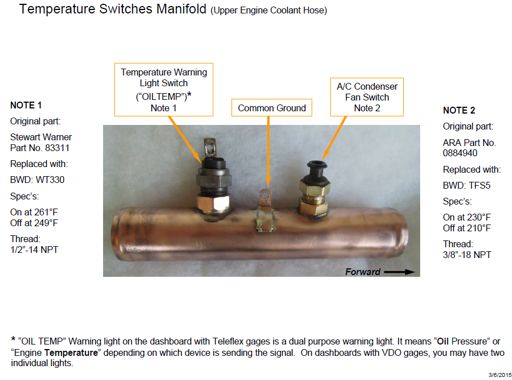
#212 Dragi Petrovich
 Return
to the Tip List. Return
to the Tip List.
Subject:
Fan Temperature Sensor
Tip:
The sensor in the upper radiator
hose closes at 220°F to turn on the (Air Conditioning) radiator fan.
Chrysler replacement part No. is 5226374. Update:
Do you know what purpose thermal switches in the upper coolant hose manifold
serve, what their open and close temperatures are, or who the manufacturers
are? The information that we have in our body of knowledge is not quite
accurate. -- Dragi
Answer: I haven't looked for a while, but
I went out and looked. It appears the white wire goes to the AC fan (mine
no longer has that fan) and the red goes to the temp gauge on the instrument
panel. Hope that helps. -- Frank DeRemer
 Return
to the Tip List. Return
to the Tip List.
Subject:
Fan Clutch Leak
Tip: Going home from the Las Vegas rally created the need
for some maintenance.
My fan clutch sprung a leak on the way down the
Cajon Pass. Fortunately, it was down hill all the way
home but when I got back, a mess had to be cleaned
up. After removing the old fan clutch and cleaning up
the fluid that spilled from the fan clutch all over the
engine, I replaced the following parts:
Fan clutch - Hayden part No. 2797
Belts - Dynaflex by Dayco:
1 - Fan & Pwr. steering pump No. 15445
1 - Fan & Air pumps No. 15525
2 - Alternator & A/C compressor No. 15605
#212 Petrovich
 Return to the Tip List. Return to the Tip List.
Subject:
Fan Clutch
Tip 1:
Spare parts for our coaches may become sparse as
time passes. If you need to replace the fan clutch, you
can use the replacement part for the Chevrolet engine
which is also a better part than the Chrysler part.
#433 Di Gilio
Tip 2:
Those of you who need a new fan clutch
may consider replacing whatever you have with a GM
part. Reportedly, the GM replacement part No. 15963247
is better than the original Chrysler part.
 Return
to the Tip List. Return
to the Tip List.
Subject:
Easy Fan Clutch Replacement
Tip:
If you need to replace the fan clutch without disturbing
the belts, there is a simple solution. Find two machine
screws 5/16 X 18 and cut off their heads to make them
about 1-1/4 inches long. Remove two opposite screws
from the fan clutch to water pump pulley and install the
two studs you just made, finger tight. Remove the other
two screws and remove the fan clutch with the fan. The
two studs you installed will keep the water pump pulley
in place until you replace the fan clutch. Reinstall in
reverse order.
Rick claims it took him longer to put away the tools then
it did to replace the clutch.
incidentally, the clutch replacement was Hayden part
number 2706.
#101 Krafft
 Return
to the Tip List. Return
to the Tip List.
 Subject:
Upgraded Radiator and Fans
Subject:
Upgraded Radiator and Fans
Tip:
Frank DeRemer just keeps changing his rig. In his latest modification feat, he
replaced the stock radiator (shown to the right) with a larger cross-flow
aluminum racing radiator that should provide better cooling ability.
|

...he also removed the existing fan and shroud and replaced it with two electric
fans (left) common on today’s cars (others in the club say that the GM fan
clutch recommended in a separate tip is a better solution than the electric
fans, so Frank plans to try going back to that to test their
theory)...
|
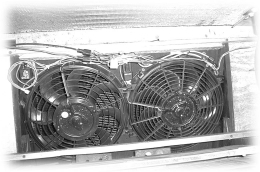 ...he then installed an 11-inch cooler for the engine oil, and another for
transmission fluid, each with an electric fan. These are in a “floor” he added
in the large space in front of and below the radiator on his 1990 Aero Cruiser.
The fans blow air downward. We are anxiously waiting the results in the
future.
...he then installed an 11-inch cooler for the engine oil, and another for
transmission fluid, each with an electric fan. These are in a “floor” he added
in the large space in front of and below the radiator on his 1990 Aero Cruiser.
The fans blow air downward. We are anxiously waiting the results in the
future.
Dragi
Update:
The results are mixed. I lose no HP to the engine having to pull air in, there is
less fan noise, and the electric fans only come on when I go up a long, steep
grade or when I sit in traffic for a long time. However, it still goes up to
230-250 degrees on those long, steep grades. Thus, I do want to try going back
to the original fan and shroud, in addition to the electric fans, to see if that
keep the temperature down even under severe stress. I will let you know it
turns out if I get around to that next experiment.
–Frank on 11/14/07. Visit Frank's site:
www.GenesisHistory.org
 Return
to the Tip List. Return
to the Tip List.
|
Subject:
Auxiliary Transmission fluid and Engine oil Cooler
| Tip:
Haris Hartman was sporting his new transmission fluid and engine oil cooler.
|
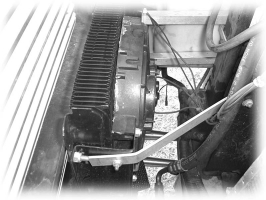 |
|
Both coolers are mounted up front
against the grill to get the maximum
air flow and each has a
powerful fan,
Dragi
 Return
to the Tip List. Return
to the Tip List.
|
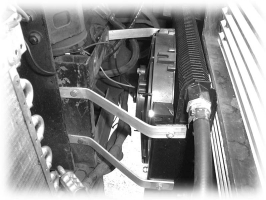 |
Subject: Coolant Recovery Bottle
Tip:
Items that may last a lifetime on a car, will not on a
motor home. Case in point, coolant recovery bottle.
New one from the Dodge dealer had to be ordered.
Chrysler part No. 5202 7784
#212 Petrovich Update: I had the same problem and replaced it with a Large Vehicle
Recovery Bottle from Kragen Auto Supply for $20. It mounted easily in the
same location.
Tom Heald
 Return to the Tip List. Return to the Tip List.
Subject:
Coolant Overflow Tube to the Recovery Bottle
Tip:
Lon’s coolant overflow tube was kinked and
allowed hot coolant to go to the reservoir but
would not allow it to come back when the engine
cooled. That lead to overheating due to lack of
coolant in the engine. Removing the kink took
care of the problem.
If you need a new coolant reservoir, you can
buy it a Dodge dealership or aftermarket in any
auto parts store.
#113 Waterson
 Return
to the Tip List. Return
to the Tip List.
Subject:
Coolant Thermostat
Tip:
If you need to replace yours, make
sure you replace it with a 195°F to maintain proper
engine operating temperature.
 Return
to the Tip List. Return
to the Tip List.
Subject:
Engine Overheating
Tip 1:
Since many trips in southern California included driving
through the desert at high temperatures,
engine overheating was the top subject of
discussion. Lon Waterson suggested keeping the engine
speed at 3,000 RPM, clean radiator, and a good fan
clutch. Pat Mogan suggested thorough cleaning of the
engine block to remove rust and deposits from the
cooling passages. Corrosion can build up just like in
the sewer pipes and prevent efficient heat exchange
with the coolant. Frank read the specification sheet
from Chrysler, which listed expected engine temperature
over a variety of ambient temperatures and concluded
that engine temperature of 240° F on a hot day
over a long grade is not uncommon.
Dragi
Tip 2:
A great deal has been done
and written on the subject over the years. Chrysler
states that the engine can run as high as 240 F.
Before you do any modifications, make sure that
you have free air flow through the heat exchangers
(radiator, air conditioner condenser, transmission
cooler, even heater core). Your fan clutch should
be operating properly, the radiator should have a
free flow of coolant, and your coolant should be at
least 50/50 concentrate of coolant and distilled
water.
If none of that works, contact Ralph Loveland or
Dragi Petrovich to see what they have done to
solve their problem.
Dragi
 Return
to the Tip List. Return
to the Tip List.
Subject:
Engine Operating Tempatures
Tip:
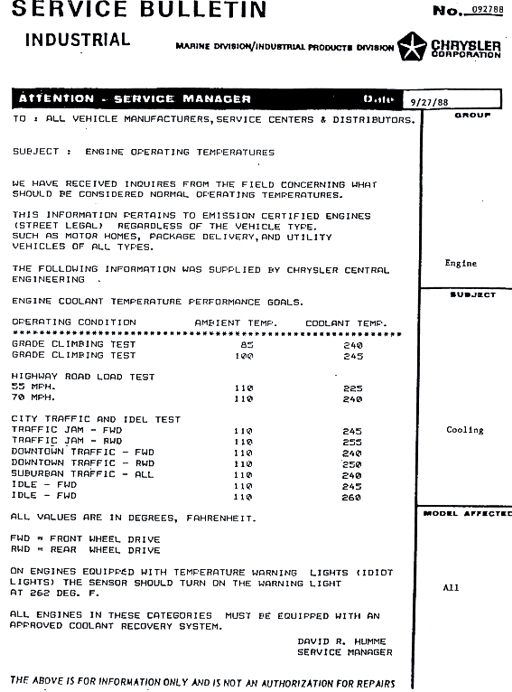
 Return
to the Tip List. Return
to the Tip List.
Subject:
Desert Cooler or Similar Device
Tip:
If you are using a device like Desert Cooler or the one
you rigged up yourself to spray water on your radiator
during hard climbs, consider using distilled water in the
spray reservoir. If you use tap water, you will have hard
water minerals buildup on your radiator over time which
will act as an insulator and you will be defeating the
purpose.
#462 Wachtell
 Return
to the Tip List. Return
to the Tip List.
Subject:
Radiator Cooling Tips
Tip: I wish I had written
this document, but I have used it to my advantage as I continue to improved
everything I touch on my 92 cruiser. I've read a lot in past newsletters, and
heard many people argue everything about cooling systems. This is the best
article on the subject and is a very good read. For those experiencing cooling
issues, follow TIPs 1, 2, 3 and 9.
Do a test, run with Water only, and no thermostat on reasonably warm day and put
in enough miles to determine the top and bottom tank temperatures. (A Laser temp
probe works great)
http://www.arrowheadradiator.com/14_rules_for_improving_engine_
cooling_system_capability_in_high-performance_automobiles.htm
Andy
 Return
to the Tip List. Return
to the Tip List.

|
Copyright© 1999-2016
Freelance Ink.
All Rights Reserved.
|

|
| 
